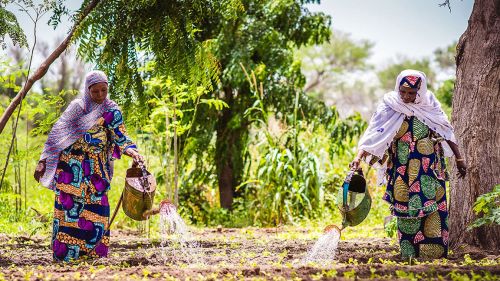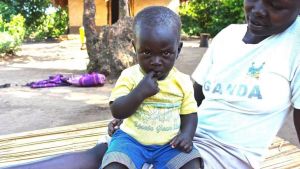From Chicago to Uganda, Clean Water is Key to Good Nutrition

Unclean water, poor sanitation, and lousy hygiene—and resulting diseases—combine with poor nutrition as the leading causes of young child mortality and stunting.
Unclean Water and Mortality
Brenda Okullu was so proud of her son, Aron. He was a robust 8 pounds at birth and continued to grow rapidly in his early months. Brenda, a smallholder farmer in northern Uganda, was cultivating the new, highly nutritious crops that had come to her area—orange flesh sweet potatoes rich in Vitamin A, as well as high-iron beans, provided by a biofortification program called Harvest Plus—and she ate them almost every day during her pregnancy and while she breastfed Aron after birth. Her top priority as a mom was to make sure her son had the best nutrition that she could provide.
That Aron was thriving was also a great relief. Brenda's first child, also a son, had died less than two weeks after birth; he had picked up an infection in the hospital. After that horrible loss, Brenda was determined to give this second son the best possible start in life. And he was indeed beating the odds of northern Uganda, where nearly half of all children were malnourished and suffered from some form of stunting, be it physical or cognitive.
Eager to show off her son, Brenda traveled by bicycle to family relatives several miles away. When she arrived, there was great celebration over the robust boy.
But the joy didn’t last long; the mood darkened when word spread through the village that an elderly neighbor had fallen sick with dysentery. Everyone knew that one incident of a water-borne disease could quickly turn into an epidemic. And it did. Soon much of the community was violently ill.
The source turned out to be an old hand-dug communal well that captured the flow of an underground spring. The water accumulated in a dirt hollow. It was in a field surrounded by tall grass, thick bushes, and trees, and was used by both humans and animals for drinking. Animals grazed in the area and also urinated and pooped. So did the people who tended the animals and those who came to collect water. The waste would seep into the groundwater and also run off into the water hollow.
The water was a greenish color. It had been a conduit of disease throughout the years; diarrhea was an all-too-common illness in the area. One bout of diarrhea just set the stage for another, as one sick person drew water from the well and potentially soiled it for others.
In this case, Brenda’s sister was the first in her family to get sick. The next day it was Brenda and Aron. Brenda feared something was wrong when her energetic boy suddenly became listless. In short order, Aron shivered with fever and his eyes swelled. Diarrhea was followed by dehydration. Brenda knew how dangerous this could be, especially for an infant.
Brenda’s father, Sylvester, rushed to get the family bike; his wife, carrying Aron, climbed on the back. Sylvester pedaled frantically over the rough dirt roads to get to the nearest clinic. The grandparents spent the night keeping watch over Aron, while Brenda lay sick herself at home. At the clinic, the nurses quickly treated Aron’s diarrhea with zinc tablets and rehydrated him with liquids. The medicine worked; within a few days, Aron was back to his active self.
As Brenda recounted the ordeal to me, she began to sob mightily, her shoulders heaving. Two months had passed and Aron was thriving once again, but his mother’s fear was still raw, frantic. All the while, Brenda told me, she had been consumed with this worry: “Am I about to lose my second child, too?”

Brenda Okullu and her son, Aron.
Brenda had done everything right on the nutrition front—growing the more nutritious crops, resisting the urge to sell them on the market, and insisting instead on keeping them to nourish her family, cooking them properly to retain the nutrients, diversifying their diet. And yet all these efforts were undermined by a few sips of bad water. It was the age-old dilemma that plagued development efforts in northern Uganda and throughout much of Africa: progress on one front, retreat on another.
Unclean water, poor sanitation, and lousy hygiene—and the diseases that result—combine with poor nutrition as the leading causes of young child mortality and stunting. At the time of Aron’s illness, diarrhea was killing about 600,000 children a year throughout the world, according to the World Health Organization.
There has been considerable progress on the WASH—Water, Sanitation, Hygiene—front in recent decades. Globally, about 2.6 billion people have gained access to an improved drinking water source since 1990, and about 2 billion people have begun using improved sanitation facilities during that time. But behind these global improvements, huge disparities remain. Access to clean water and improved sanitation varies widely in the developing world. More than 600 million people worldwide still use unimproved drinking water sources. And more than 2 billion people still either used unimproved sanitation facilities, such as uncovered latrines, or they defecated in the open. Most of these cases of poor water and sanitation were in sub-Saharan Africa and South Asia.
In Uganda, 30 percent of children were without access to safe water when Aron fell ill, according to a government report. But “access” didn’t mean turning a tap on a nearby faucet. Nearly two-thirds were at least a 30 minutes round-trip walk from a safe water source, and more than one-third were 60 minutes away. The greatest distances were in the northern region, where Brenda lived, with three-quarters of the children at least 30 minutes away from safe drinking water. About 70 percent of Uganda’s rural population used some type of latrine, but there were large disparities across the country. The proportion of children with no toilet at home in the northern region was seven times greater than in the Central region. The most troubling statistic was that only eight percent of Uganda’s population had a handwashing facility at home with readily available soap and water.
One result of this poor access to safe water and improved sanitation was that one-quarter of Uganda’s children suffered severe diarrhea or dysentery. Diarrhea sapped vital micronutrients out of the body and left children weaker and more vulnerable to other diseases and infections, particularly malaria. Malnutrition allied with diarrhea and malaria to form the most deadly combination against children in Uganda.
The need to form a new alliance between good nutrition and clean water was a traumatic lesson that Brenda would never forget.
This lesson was on display wherever I went while reporting The First 1,000 Days book, which chronicles the importance of proper nutrition, and all that supports it, in the lives of mothers and children in Uganda, India, Guatemala, and Chicago.
In Guatemala, lab technicians celebrated the results of testing when a group of 16 children from a kindergarten class in the western highlands came to their clinic for an annual checkup and health lesson. Each child brought a stool sample to be tested.
“A big success!” declared the lab technician, announcing the results. “Only 14 have parasites. On most days, it would be 15 out of 16, or 16 of 16.”
That “only” 14 rated as a success indicated the toxic mixture of poor nutrition and poor sanitation leading to widespread stunting of Guatemalan children. Nationwide, nearly half of all children under five suffered from chronic malnutrition. In the western highlands, it was about 70 percent. More than one-quarter of the rural population didn’t have access to clean sanitation facilities. The endemic presence of parasites, beginning in a child’s first months, can trigger malnutrition by absorbing nutrients meant for the human body. Malnutrition isn’t only due to a lack of nutritious food; it can be exacerbated by worms, bacteria, aflatoxins, and pathogens found in the food, water, and soil. The impact of poor sanitation in the first 1,000 Days, from a mother’s pregnancy to the child’s second birthday, can last a lifetime.
“People here live and die with parasites,” the lab technician explained. “It’s one of the reasons that Guatemala has such a malnutrition problem, and stunting. The children just stay short and small.”
In Chicago, new moms were literally putting WASH into practice.
“What’s the first thing we do?,” Celeste Bowen asked as she walked into Quintana Woodridge’s split-level rowhouse in Chicago. Quintana was the mother of one-year-old daughter ShaLawn. Celeste, from the Ounce of Prevention Fund’s Healthy Parents and Babies home visitation team, stopped by once a week to see how they were doing.
“We wash our hands,” Quintana answered. “That’s what we do first.” She and ShaLawn scurried off to the bathroom, singing “Wash, wash, wash, we wash our hands,” to the tune of the Beach Boys’ “Barbara Ann.” They scrubbed under a faucet, using plenty of soap, then returned to the living room, waving their wet hands and singing like Taylor Swift, “Shake it off.”
As Brenda in Uganda had learned, cleanliness was next good nutrition in Chicago, too.
In India, the Kumar family in rural Uttar Pradesh celebrated the completion of their new outhouse. Until then, like most rural families, they defecated in the open. India led the world in the rates of open defecation, and in the absolute number of malnourished children. It wasn’t a coincidence, for in India poor nutrition and poor WASH conditions formed a particularly debilitating partnership.
The Indian government had launched a massive campaign to build millions of toilets across the country, but they were slow to arrive in the Kumars’ village. So the family began to invest its meager income in a latrine across the path behind their house. It became a priority as stomach and intestinal illness persisted in the family, among both children and adults. After the last outhouse piece—the door!—was in place, the family painted the concrete walls blue.
The color of clean water.
"Unchartered Waters" Series
- Farmer-Led Irrigation for Agricultural Intensification
- Achieving Food and Nutrition Security in the Face of Water Scarcity
- Growing Cities, Changing Diets
- The Livestock Ladder’s Water Footprint
- Are the Sustainable Development Goals for Water and Food Working Against One An…
- From Chicago to Uganda, Clean Water is Key to Good Nutrition
- The Gendered Burden of Water

